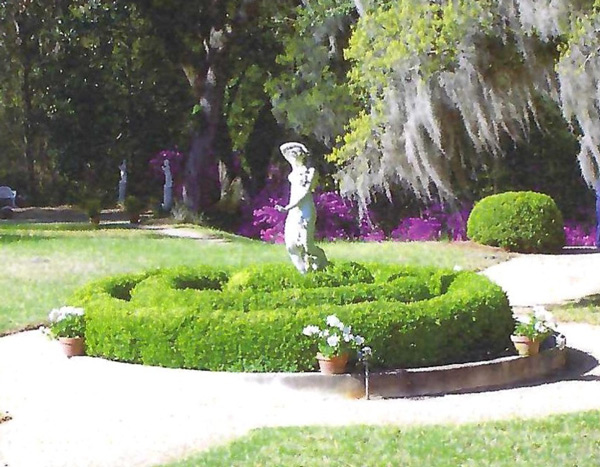In 1915, Dr. Robert Lewis and his wife Addie bought Afton, and it is said Dr. Lewis, a courageous gardener, was there to rescue the gardens. Upon arrival, he found the terraces below the parterre used as sharecropper’ fields of corn, cotton, and potatoes. One day while working in the fields, his spade hit something hard, and he suddenly realized that he had unearthed a flight of the old terrace steps. Because the farsighted original gardener had put down a network of underground brick drains in the 1840s to combat erosion, the grounds remained firm, and Dr. Lewis was able to laboriously slough off the fields to get back to the original contours of the terraces.

In the 1980s, the Trimbles restored an original gravel path from the Parterre Garden all the way down the terraces connecting the old flights of steps. On the second-to-last terrace, on a straight line with the projected path, there is a round bed framed by boxwood and centered by one of the original garden statues. More than seven feet tall and carved of Italian marble, her face lined by the erosion of time, and her abundant, long, wavy hair blown back as if by an invisible wind, reminiscent of the prow of some ancient Roman ship set out on a high sea.
Beneath the ancient live oak tree just off the gravel path near the statue you can look back, upward and beyond, to get a panoramic view of the terraces, the flights of old steps, the parterre, and, once upon a time, the tall towers of the Villa over the tops of the trees. The Grand Staircase was restored!
As you continue past the round bed and statue, you’ll reach the next set of steps. Far down in the ravine before you, now filled with volunteer beech, oak, and pine, was once the setting of Susan Barrow’s hothouses-where she grew seasonal cut flowers for arrangements in her house-as well as her extensive pineapple beds.
Please proceed down the steps, then turn left and follow the gravel walkway to our next destination, The Music Room.